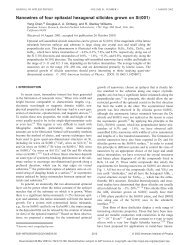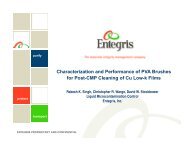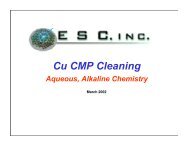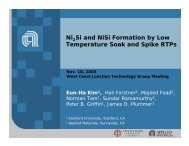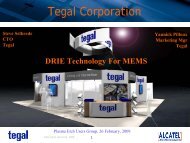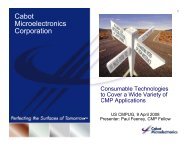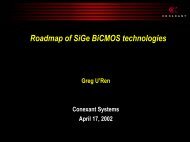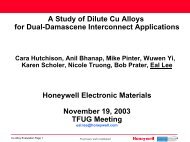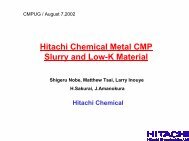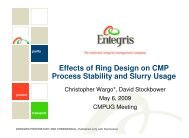The Ever Expanding Need for Planarization - NCCAVS - User Groups
The Ever Expanding Need for Planarization - NCCAVS - User Groups
The Ever Expanding Need for Planarization - NCCAVS - User Groups
You also want an ePaper? Increase the reach of your titles
YUMPU automatically turns print PDFs into web optimized ePapers that Google loves.
Paul Feeney<br />
Semicon West 2011 US CMPUG Seminar<br />
FeeneyP@Rocketmail.com
Outline<br />
• Semiconductor BEOL and FEOL directions<br />
• Semiconductor BEOL and FEOL planarization<br />
applications<br />
• <strong>Expanding</strong> number of applications and steps<br />
• Summary
Source: ITRS 2009
Smaller Lines Have Exponentially Worse<br />
Resistance<br />
Year of Production 2009 2010 2011 2012 2013 2014 2015<br />
MP U/ASIC Meta l 1 ½ Pitch (nm)(contacted ) 54 45 38 32 27 24 21<br />
Cu Effective Resistivity (μΩ-cm) 3.8 4.08 4.30 4.53 4.83 5.2 5.58<br />
Minimum Density (nm-2) 0188 0.188 0175 0.175 0.166 0.158 0.148 0138 0.138 0128 0.128<br />
Cu lines have resistance >> bulk copper as lines get smaller<br />
‐ Drives even higher importance of film loss control and defects<br />
‐ Research being done on replacements <strong>for</strong> Cu electrical wires<br />
5<br />
4<br />
side<br />
wall<br />
Res<br />
sistivity [µ cm]<br />
3<br />
2<br />
grain boundary<br />
1 bulk resistivity<br />
0<br />
10 100 1000<br />
Linewidth (nm)<br />
[nm]<br />
Source: ITRS 2009
2010 Barrier/Nucleation/Resistivity<br />
Year of Production 2010 2011 2012 2013 2014 2015<br />
MPU/ASIC Metal 1 ½ Pitch<br />
(nm)(contacted)<br />
Barrier cladding thickness<br />
Metal 1 (nm)<br />
Conductor effective resistivity<br />
(µΩ-cm) Cu Metal 1<br />
45 38 32 27 24 21<br />
33 3.3 29 2.9 26 2.6 24 2.4 21 2.1 19 1.9<br />
4.08 4.30 4.53 4.83 5.2 5.58<br />
Year of Production 2016 2017 2018 2019 2020 2021 2022 2023 2024<br />
MPU/ASIC Metal 1 ½ Pitch<br />
(nm)(contacted)<br />
Barrier cladding thickness<br />
Metal 1 (nm)<br />
Conductor effective resistivity<br />
(µΩ-cm) Cu Metal 1<br />
18.9 16.9 15.0 13.4 11.9 10.6 9.5 8.4 7.5<br />
1.7 1.5 1.3` 1.2 1.1 1.0 0.9 0.8 0.7<br />
6.01 6.33 6.7 7.34 8.19 8.51 9.84 11.30 12.91<br />
• ALD barrier processes and metal capping layers <strong>for</strong> Cu are<br />
lagging in introduction – key challenge<br />
• Resistivity increases due to scattering and impact of liners<br />
•No known practical solutions<br />
-5-<br />
ITRS 2010 Summer Conference – 14 July 2010 San Francisco, CA
Cu Contact Transition Prospective<br />
• 5% of total parasitic resistance <strong>for</strong> contact resistance<br />
(agreed with PIDS, FEP and INTC in 2008)<br />
• Estimation of contact resistance used to <strong>for</strong>ecast timing <strong>for</strong> Cu<br />
ITRS<br />
Commercial<br />
/contact)<br />
Resis stance (<br />
200<br />
150<br />
100<br />
50<br />
65~54nm 45~32nm 27~21nm 19nm~<br />
45/40nm 32/28nm 22/20nm<br />
15nm<br />
Target<br />
W-plug<br />
Cu-plug<br />
OK<br />
marginal<br />
NG<br />
0<br />
2007 2010 2013 2016<br />
Year<br />
W-plug will be applicable<br />
until 22/20nm node at<br />
2013.<br />
Cu-plug will be able to<br />
satisfy the requirement<br />
beyond 15/14nm node<br />
after 2016.<br />
Assumption<br />
•Aspect ratio=5.5<br />
•Barrier <strong>for</strong> W-plug<br />
PVD-Ti 10nm@btm, 2nm@side<br />
CVD-TiN 5nm@btm/side<br />
•Barrier B i <strong>for</strong> Cu-plug<br />
PVD-Ta(X) 5nm@btm, 1nm@side<br />
CVD-Ru(X) 2nm@btm/side<br />
ITRS 2010 Summer Conference – 14 July 2010 San Francisco, CA
Donald Canaperi<br />
November 14, 2010<br />
Line Resistance Variation vs.Technology Node<br />
‣ <strong>The</strong> ef<strong>for</strong>t to control RC time constant grows more challenging g at each node<br />
‣ Capacitance has been driven down using low-k and ultra low-k dielectrics<br />
‣ Resistance has been increasing as the critical dimension shrinks<br />
‣ <strong>The</strong> CMP process has a direct impact on line resistance variability<br />
7<br />
Source: Canaperi et al, ICPT 2010<br />
© 2010 IBM Corporation
2010 Low k or nothing<br />
Year of Production 2010 2011 2012 2013 2014 2015<br />
MPU/ASIC Metal 1 ½ Pitch<br />
(nm)(contacted)<br />
Interlevel metal insulator –<br />
bulk dielectric constant (κ)<br />
45 38 32 27 24 21<br />
2.3-2.5 2.3-2.5 2.3-2.5 2.1-2.3 2.1-2.3 2.1-2.3<br />
Year of Production 2016 2017 2018 2019 2020 2021 2022 2023 2024<br />
MPU/ASIC Metal 1 ½ Pitch<br />
(nm)(contacted)<br />
Interlevel metal insulator –<br />
bulk lkdielectric i constant t( (κ)<br />
18.9 16.9 15.0 13.4 11.9 10.6 9.5 8.4 7.5<br />
1.9–2.1 1.9–2.1 1.9–2.1 1.7–1.9 1.7–1.9 1.7–1.9 1.5–1.7 1.5–1.7 1.5–1.7<br />
Air gap architectures will be required <strong>for</strong> bulk
3D Integrated dCircuits i Now in Main Mi Sections<br />
Si<br />
wafer<br />
FEOL<br />
device<br />
layer<br />
local BEOL<br />
inte<br />
interconnect wiring<br />
rmediate global<br />
Figure INTC 1: Schematic representation of TSV first, middle and last processes<br />
Global Level, W2W,D2W or D2D 3D-stacking 2009-2012 2012 2012-2015<br />
2015<br />
Minimum TSV diameter 4-8 µm 2-4µm<br />
Minimum TSV pitch 8-16 µm 4-8 µm<br />
Minimum TSVdepth 20-50 µm 20-50 µm<br />
Maximum TSV aspect ratio 5:1 – 10:1 10:1 – 20:1<br />
Bonding overlay accuracy 1.0-1.5 µm 0.5-1.0 µm<br />
Minimum contact pitch (thermocompression) 10 µm 5 µm<br />
Minimum contact pitch (solder µbump) 20 µm 10 µm<br />
Number of tiers 2-3 2-4<br />
Table INTC3 : Global interconnect level 3D‐SIC/3D‐SOC roadmap<br />
Source: ITRS 2009
1 st Generation HKMG: 45nm<br />
MC<br />
W<br />
Al<br />
NMOS<br />
PMOS<br />
SiGe<br />
Source: IEDM 2009<br />
• SiGe S/D integration <strong>for</strong> PMOS only<br />
• HfO 2 based high‐k material a <strong>for</strong> gate oxide<br />
• 3 ILD layers with nitride stress liner<br />
• Single W contact process<br />
• POP and Al CMP applications<br />
Source: Feeney et al, Taiwan CMPUG 2010
2 nd Generation HKMG: 32nm<br />
Cu<br />
Ta<br />
M0<br />
Al<br />
MC<br />
SiC<br />
NMOS<br />
PMOS<br />
SiGe<br />
Source: IEDM 2009<br />
• Raised S/D <strong>for</strong> NMOS with SiGe <strong>for</strong> PMOS<br />
• Extended high‐k surrounding metal gate<br />
• Gate size is 3 times smaller than M1<br />
• Dual contacts with MC W & M0 Cu with Ta based barrier<br />
• W‐Al buff process required<br />
Source: Feeney et al, Taiwan CMPUG 2010
Transistors Will See More Change<br />
Source: ITRS 2009
2011 ITWG Interconnect tDielectric<br />
i<br />
<strong>Planarization</strong> Applications ‐ DRAFT<br />
First Year of IC Production<br />
DRAM 1/2 Pitch<br />
2009<br />
50nm<br />
2010<br />
45nm<br />
2011<br />
40nm<br />
2012<br />
35nm<br />
2013<br />
32nm<br />
2014<br />
28nm<br />
2015<br />
25nm<br />
2016<br />
22nm<br />
2017<br />
20nm<br />
2018<br />
18 nm<br />
2019<br />
16 nm<br />
MAJOR APPLICATIONS<br />
Dielectrics<br />
Premetal dielectric (PMD)<br />
[target & selective]<br />
Dielectric on poly (POP)<br />
[metal gate, flash]<br />
Interlevel dielectric (ILD)<br />
[memory]<br />
LK/ULK dielectric (PMD/ILD)<br />
[NVRAM, air gap, PMD]<br />
Backside Si<br />
[thinning, 3DIC]<br />
Backside dielectric<br />
[3DIC]<br />
Research Required<br />
Development Underway<br />
Qualification / Pre-Production<br />
Continuous Improvement
2011 Metal Applications ‐ DRAFT<br />
First Year of IC Production 2009 2010 2011 2012 2013 2014 2015 2016 2017 2018 2019<br />
DRAM 1/2 Pitch 50nm 45nm 40nm 35nm 32nm 28nm 25nm 22nm 20nm 18 nm 16 nm<br />
Conductors<br />
Aluminum/WF metals<br />
[metal gate]<br />
Polysilicon<br />
[selective]<br />
Tungsten/buff <strong>for</strong> contact/via<br />
[selective & nonselective]<br />
New contact/local interconnect<br />
[logic]<br />
Tungsten/buff <strong>for</strong> bit/word lines<br />
[memory]<br />
Capacitor (Ru, Pt)<br />
[DRAM]<br />
Copper/barrier/diel<br />
[4.0 > κ eff > 2.5]<br />
Cu/barrier/hardmask/diel<br />
[2.7 > κ eff > 2.0]<br />
Cu/barrier (Ru, Co, Mn)/HM/diel<br />
[2.2 > κ eff > 1.4]<br />
NVRAM cell (GST, PZT, Ni, Fe)<br />
[PRAM, MRAM, FeRAM]<br />
Metal/barrier/diel <strong>for</strong> 3DIC<br />
[memory, logic]
FEOL <strong>Planarization</strong> Applications<br />
First Year of IC Production<br />
2009<br />
2010<br />
2011<br />
2012<br />
2013<br />
2014<br />
2015<br />
2016<br />
2017<br />
2018<br />
2019<br />
DRAM 1/2 Pitch<br />
50nm 45nm 40nm 35nm 32nm 28nm 25nm 22nm 20nm 18 nm 16 nm<br />
MAJOR APPLICATIONS<br />
Direct STI<br />
[logic & memory]<br />
Transistor matls (Si/Ge/C, III-V)<br />
[logic]<br />
Gate materials<br />
[FinFET poly, RCAT, stressor]<br />
Other<br />
[3D flash, patterning, ...]<br />
Research Required<br />
Development Underway<br />
Qualification / Pre-Production<br />
Continuous Improvement
HKMG Multi‐Step CMP Applications<br />
ILD3<br />
ILD2<br />
1. Poly Opening Polish<br />
ILD3<br />
ILD2<br />
ILD 1.2.3 Deposition<br />
ILD1<br />
ILD1<br />
2. Al Bulk / Al Buff CMP<br />
3. W Bulk / /W‐Al Buff CMP<br />
Al<br />
W<br />
Al<br />
Al<br />
©2010 Cabot Microelectronics<br />
Corporation CONFIDENTIAL<br />
Source: Feeney et al, Taiwan CMPUG 2010
Donald Canaperi<br />
November 14, 2010<br />
Approach to Meeting Today’s Tolerances: Copper CMP <strong>for</strong> Interconnects<br />
1) Copper CMP<br />
2) “Barrier” CMP<br />
Liner/seed Hardmask 2<br />
Hardmask 1<br />
ULK<br />
Dielectric<br />
Cap<br />
Dielectric<br />
‣ Traditional CMP <strong>for</strong> interconnects is a two step process<br />
1) Copper CMP stopping on barrier<br />
2) Barrier CMP to non-selectively remove liner, hardmasks, and some dielectric<br />
‣ Approach <strong>for</strong> upcoming nodes is to tailor the selectivity of each step<br />
-Copper CMP stopping on barrier<br />
-Selective removal, if necessary, of barrier stopping on hardmask<br />
-CMP of hardmask with tailored selectivity to slow down/stop in ULK dielectric<br />
17<br />
Source: Canaperi et al, ICPT 2010<br />
© 2010 IBM Corporation
Logic CMP Steps Growing Long Term<br />
1 u 0.25 u 65 nm 16 nm<br />
CMP Steps Passes CMP Steps Passes CMP Steps Passes CMP Steps Passes<br />
None 0 Indirect STI 1 Direct STI Bulk 1 Direct STI Bulk 1<br />
Premetal Diel 1 Direct STI Final 1 Direct STI Final 1<br />
W Contact 1 Premetal Diel 1 Premetal Diel 1<br />
W Contact Buff 1 W Contact 1 Metal Gate 1<br />
WBuff 1 Stress Film 2<br />
Epi/Other 2<br />
Contact Bulk 1<br />
Contact Final 1<br />
Contact Buff 1<br />
None 0 W Via 4 Cu Bulk 8 Cu Bulk 7<br />
W Via Buff 4 Cu Final 8 Cu Final 7<br />
Interlevel Diel 4 Ta Barrier 8 Ta Barrier 7<br />
BEOL Min 1 4<br />
BEOL Min 2 4<br />
BEOL Min 3 4<br />
Cu TSV Bulk 1<br />
Cu TSV Final 1<br />
TSV Barrier 1<br />
Total 0 Total 16 Total 29 Total 47<br />
Extension, New<br />
Source: Feeney, ICPT2008
Corollary to Moore: Add 4 CMP Steps/Node<br />
50<br />
CMP St teps Utiliz zed<br />
40<br />
30<br />
20<br />
10<br />
BEOL New<br />
BEOL Existing<br />
FEOL New<br />
FEOL Existing<br />
0<br />
1u / 0 0.25u / 4 65nm / 8 16nm / 12<br />
Technology Node/Generation<br />
Slurries: 0 2 6 11<br />
Source: Feeney, ICPT2008
Developing Finishing Solutions <strong>for</strong> Multiple<br />
Applications<br />
• Prime Pi Silicon Wafer<br />
• Data Storage/Hard Disk Drive<br />
• Flat Panel Displays<br />
• Precision Optics<br />
• Compound Semiconductor<br />
• Healthcare<br />
• Defense/Aerospace<br />
• Solar Energy<br />
Source: Feeney et al, US CMPUG 2008
Summary<br />
• Continued innovation in Semiconductors is accelerating the changes<br />
in structures and materials, especially <strong>for</strong> transistors<br />
• Several planarization applications require development today<br />
• Complexity of applications i is driving ii more multi‐step li processes<br />
• Expect the planarization universe to continue expanding at a rate of<br />
4 steps per technology generation<br />
• <strong>Need</strong> to acknowledge the contribution of many people from Cabot<br />
Microelectronics, IBM, and the ITRS <strong>Groups</strong><br />
• Are there other important applications not discussed here
Paul Feeney<br />
Semicon West 2011 US CMPUG Seminar<br />
FeeneyP@Rocketmail.com



